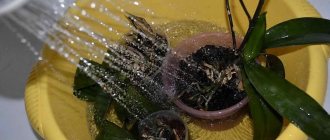Do you have an orchid growing, but you don’t know how to replant it at home? Read the article, it contains a lot of useful tips and instructions.
The orchid, just like the rose, can be called the queen of flowers. Graceful flowers, decorative leaves, intertwining roots and stems create a plant of incredible beauty. But this flower, like all the others, needs good care, an important component of which is replanting. It needs to be done correctly and on time - the further development of the plant and the abundance of flowering, as well as the duration of the adaptation process, depend on this.
Read another article on our website that tells how to propagate an orchid at home with children, cuttings, roots, and seeds. All methods are described in detail.
This article describes the timing, as well as the rules for transplanting a home orchid. You will learn how to replant a flower after the store and why to do it at all. Read on.
Why replant an orchid when grown at home: is it replanted at all, is it possible?
Orchid transplantation at home
Various circumstances may arise under which a transplant is performed. Why replant an orchid when growing it at home? Is it possible to replant at all? Yes, this can and should be done. Here are the circumstances under which flower breeding experts advise doing this:
- Replanting is required once every 3-4 years after purchasing or replanting the plant.
- If it is noticed that the roots have begun to appear from the pot, i.e. it has become too small for the plant.
- If the orchid is very sick, all its leaves begin to turn yellow.
- Unsightly appearance and condition of the substrate in which the flower grows. Mold or severe dryness of the upper fragments has appeared on the surface, which indicates a loss of the filler’s ability to pass water and air.
- The plant does not bloom for several years, and then it needs a good shake-up in the form of a transplant.
- If necessary, divide the orchid.
If these signs are not observed, it is better not to touch the orchid - it does not really like to be disturbed. It is also not recommended to do this during the flowering process; it is better to wait until it is over, unless an urgent transplant is needed.
How often should the procedure be repeated?
It is recommended to replant the flower once a year, after a maximum of two years, as the substrate loses its quality. The roots grow significantly over the course of a year and take up all the available space. And if their habitat is disturbed, they rot.
The issue of transplantation should be approached carefully. As soon as the plant blooms for the first time, there is no need to replant it immediately. If it has healthy, strong leaves of a rich green color, then you should not disturb it for another year or year and a half.
Timing: when can an orchid be replanted?
Replanting an orchid at home
This operation should be carried out when the dormant period of the inflorescences and the entire plant has ended. But there are types of orchids in which the dormant period is weakly expressed, for example, phalaenopsis, which blooms almost all year round with short breaks. Therefore, if new shoots of a plant do not develop in the absence of signs of disease, it means that it is entering a dormant period. This is the best time to replant. This time usually occurs in the spring - late February and March. This is the best time to replant an orchid.
What time of year is best to do the procedure?
It is recommended to replant phalaenopsis in late winter or early spring, between February 15 and March 30. This time will be the most favorable for transplantation. However, if this is not possible, then this can be done at other times of the year, but with great caution. So, autumn is the second most favorable for transplantation.
Summer is not suitable for this procedure; during extreme heat, the phalaenopsis experiences stress and may not survive the transplant. In winter, the plant is in conditional hibernation, the growth process is extremely slow, which is also not good for transplantation.
Frequency of orchid transplantation at home: how often?
Replanting an orchid at home
Many novice flower lovers ask the question: “How often to replant an orchid?” . What determines the frequency of transplanting inflorescences at home?
- The answer to this question depends on what composition of the substrate is in the container.
- It may consist of moss, and then it needs to be replanted more often - once every two years .
- If the main part of the substrate is bark, which decomposes more slowly, then you can replant it once every three years.
Of course, these dates are indicated for planned replantings, when the inflorescence looks completely healthy and has no signs of damage by insects.
Growing up period
Phalaenopsis
It is difficult to answer this question unambiguously; it all depends on the variety and type of orchid. In some varieties of Phalaenopsis, the offspring grow their roots quite quickly .
Having a very modest size, however, it is ready to be separated from the mother plant.
There are varieties that do not want to grow roots, preferring to feed from the mother . Even having reached impressive sizes, they are not ready to live on their own.
The main thing here is to be patient and wait for roots that can feed the young orchid. The process can take from several months to several years.
Wanda
In the cases of Vandas and Angrekums, the process of growing their own roots can take many years. In this case, both the mother plant and the baby plant can bloom. In these orchid species, experienced orchid growers are in no hurry to plant young offspring, since a young plant that blooms early will continue to bloom from an earlier age after resettlement.
Moreover, the babies of these species are formed only on the trunks and never on the peduncles. When the offspring are separated from the trunk, the mother plant is greatly injured, which weakens the orchid, so it may refuse to flower for a long time.
Wanda's children grow only on the trunk.
To separate young orchids, they most often wait until the Vandas have produced a sufficient number of roots above the point where the baby appears and cut off the lower part of the trunk along with it. Young Wanda becomes the owner of a large number of roots that can feed her.
Dendrobium-Nobile
This type of orchid grows its offspring very quickly , while simultaneously growing a new pseudobulb. Typically, by the time a young tuber has completed its development, the Dendrobium nobile offspring are ready to separate from the mother plant and have enough roots to grow on their own.
Baby Dendrobium Nobile.
There is no need to delay the resettlement process, since children must be kept warm and regularly watered in order to further grow up. And after the young pseudobulb has fully matured, the mother plant is placed in more severe conditions and practically does not see water.
Substrate for orchid transplantation at home: what is it made of?
Substrate for transplanting orchids at home
To transplant orchids at home, you need to choose a high-quality substrate. The health and further flowering process of the plant largely depends on this. What is it made of? You can buy a specialized one at retail outlets, but it comes in two types:
- For epiphytic (i.e. with aerial roots). It's called Phalaenopsis Mixture.
- For terrestrials - “Mixture for Cymbidium”.
The first mixture is used for flowers growing on trees with long aerial roots. Therefore, the substrate for them must be breathable, because the roots of these flowers take part in photosynthesis and they do not need soil, only moisture, to grow. The composition of such mixtures usually includes:
- Pine bark
- Ground fern root
- Activated carbon
- Cut cork
- Sphagnum in small quantities
The second type of mixture is denser, because it is intended for orchids living on the ground. It contains more of these ingredients:
- Sphagnum moss
- Lowland peat
- Leaf ground
- Coal
Sometimes various synthetic materials, such as perlite or foam, are used as a substrate. You can also use:
- Expanded clay
- Shell rock
- Pumice
The substrate can be made at home. Pine bark is used for this:
- First disinfect it - hold it over steam for half an hour or boil it in water.
- After this, dry and boil again. This treatment kills all pathogenic organisms.
- Place to dry again and then cut into pieces up to 2 cm .
To the bark prepared in this way, add dry and finely chopped sphagnum moss and just a little peat coal. You can now fill the pots with this mixture.
Which pot is best to replant a home orchid?
It is better to replant the orchid in a transparent pot.
Most orchids have large roots that like to entwine the pot from the inside and even look out. Therefore, when choosing a new container for a flower, you need to focus primarily on the size of the root system. But, given that the base of the flower will grow further, you need to add a few centimeters to the diameter. Which pot is best to replant a home orchid?
Worth knowing: For a large orchid with intensive growth, you can buy a pot, as they say, “for growth,” so as not to replant it often.
Orchid lovers most often grow their “beauties” in plastic transparent pots or containers. What are the advantages of such containers? Here is the answer:
- The roots are clearly visible and you can constantly monitor their condition. With normal soil moisture, the roots are usually green, but as the substrate dries, they gradually turn gray, which indicates the need for watering.
- In plastic containers, unlike clay ones, the roots do not grow to the walls of the container and therefore are not injured during replanting.
Although clay containers have their advantages:
- In them, the base-root does not overheat, which is very important for orchids.
- Do not overwater the plant because the moisture will last longer.
- In addition, a clay pot is much heavier than a plastic one and therefore will not tip over. Orchids are planted in such pots, some of the roots of which completely dry out and die during the dormant period.
Be sure to make drainage holes in the containers. This will provide the roots with faster drying and ventilation, which will protect them from rotting. Flower lovers with no experience often overwater the plant for fear of drying it out. Drainage holes will help in this case too.
Worth knowing: Plastic containers have one drawback - they have a rather simple, not very sophisticated appearance, compared to the flower itself. To correct this shortcoming, you can buy a beautiful flowerpot that will completely hide the plastic.
There is another way out - you can put a plastic pot in a low glass vase. The space between the walls of the vase and the pot is filled with some kind of jewelry or tinsel, balls or floral fillers. This needs to be done carefully so that the multi-colored filler does not distract from the beauty of the orchid flowers.
Remember: Do not buy large containers for orchids. In small ones - up to 15 cm in diameter, it feels much better and blooms longer.
Strengthening the orchid
Due to the fact that the stem of the plant was not covered, it does not immediately become sufficiently stable. In addition, its root system lacks the thin shoots that allow most other flowers to quickly establish themselves in the soil. This means that the florist needs to take on this work. Even minor movements, just a couple of millimeters, will cause the root to be injured and the plant will not grow for some time.
Luckily, there are quite a few ways to solve this problem. The most elegant solution is to use special fasteners. You can buy it in special stores. A piece of thin wire is attached to the edges of the pot and securely fixes the plant in one place. If desired, such fasteners can be made manually - you only need a small piece of wire. The advantage is reliability and stealth.
Some orchid lovers prefer another option - stick a strong and long stick (or better yet, two) into the substrate, to which the flower will be tied. To do this, you can use Chinese chopsticks, which often come with sushi and rolls. The main thing is that when sticking a stick into the substrate, do not damage the root system. Overall, this is a simple and convenient solution.
There is another method for which you will need old nylon tights. To do this, the orchid is simply wrapped in several layers of tights, the ends of which are securely fixed at the edges. Of course, it doesn't look particularly elegant. But there is no need to worry, because this is only for a while. After about two to three weeks, the orchid's roots will have developed enough to support the flower in the pot. After this, the tights can be removed.
How to transplant children, one child, a shoot of a home orchid: step-by-step instructions
Replanting a baby home orchid
An orchid growing in normal, ideal conditions can produce young shoots, or babies. This is a great opportunity to propagate the plant. What should be done? How to transplant children, one child, a shoot of a home orchid? Here are the instructions step by step:
- The baby should have fairly long roots - more than 5 cm and 3-4 leaves - these are the most suitable parameters for transplantation.
- Children usually appear on the stem or near the root collar. Using a sharp knife, you need to cut off part of the stem with the baby, stepping back to the sides at a distance of about 1 cm . Sprinkle the cut area with coal.
- Prepare a small glass in advance, preferably a plastic one, and add a small layer of drainage.
- Place the baby in a glass and carefully cover it with substrate. for the first 3-4 days .
- Place the glass with the baby in a place where the air humidity is high. You can simply spray the surface of the window sill where the glass is located more often. Try not to get it on the leaves.
The baby will grow in such a container for about a year, after which it can be transplanted into a larger container. An orchid grown from a child will bloom in three years .
Further proper care of the phalaenopsis orchid plant after transplantation, growing conditions
After replanting, you need to provide proper and timely further care for the orchid. Here are the conditions for growing a phalaenopsis orchid plant:
Proper care of an orchid is to shade the window so that the sun does not burn the leaves of the flower.
- As mentioned above, immediately after the transplantation is made, the container is placed on a sunny windowsill for a week, but shaded from direct sunlight. Otherwise, if this is not done, the orchid leaves will lose their decorative appearance, wrinkle and become wilted.
You can water the flower after transplanting only after a couple of weeks.
- water the plant after replanting only after 2 weeks . The fact is that orchid roots are susceptible to various fungal diseases. Therefore, the root system needs to be slightly dried to avoid this. Find out how to properly water an orchid here .
Spraying the plant so as not to dry it out
- But, in order not to dry out the plant, spray the leaves, or, even better, wipe them with a wet sponge. In this case, under no circumstances should water get into the depths of the rosette of leaves. This can lead to their rotting.
Orchid grows at optimal temperature
- It is important to maintain optimal temperature. The orchid does not like heat, it needs a temperature no higher than +21-22°C , but it should not fall below 18°C . Otherwise, the inflorescences get stressed, which is very undesirable for these sissies.
Feed the orchid
- A blooming orchid needs feeding. Use only mineral mixtures. Organic ones are not suitable for feeding flowers, since they can introduce diseases into the soil.
Excessive nitrogen nutrition can cause leaf growth to the detriment of flowering. Nowadays you can find special fertilizer compounds for orchids in stores. In any case, it will be good to use an all-purpose fertilizer for flowering plants. They must be diluted strictly according to the instructions so as not to harm the flower. They need to be added along with water for irrigation.
How to feed an orchid in winter
Having reduced watering of indoor plants, do not forget about fertilizing. Orchids can be fed once a month in winter. The resulting nutrients are sufficient to prepare for spring flowering and to maintain vital functions.
You can apply fertilizer in any convenient way. Some people add liquid fertilizer to the water. You can wipe the leaves by moistening a napkin with a nutritious preparation.
In order not to forget to feed, you can make it a rule to feed orchids in winter every first day of the month.
The choice of fertilizers is purely individual. Any complex preparation that contains a sufficient amount of vitamins, nitrogen, phosphorus, which every plant needs, is suitable.
If there is no flowering after transplantation: what to do?
Lack of flowering after transplantation
After transplantation, the orchid should increase its green mass and bloom after a certain time. This usually happens after 3-4 months . But what if the inflorescences do not appear for much longer? What to do if there is no flowering after transplantation? This problem can occur for several reasons:
- The plant is overfed with nitrogen fertilizers , active leaf growth is observed, they become larger than they should be during normal development. In this case, feeding should be stopped for a month.
- The transplant was not carried out in a timely manner . For example, if for some reason an orchid was transplanted at the time when it bloomed last year, then it most likely will not bloom this year. The plant will direct all its energy to restoring its root system, and not to flowering.
- Perhaps you made mistakes during transplantation . If the plant is not firmly fixed in the substrate, then when you move the pot, it begins to dangle in it, and the roots and stems will receive microtrauma. The plant does not have the opportunity to direct its energy to flowering, experiencing constant stress.
- Insufficient lighting and low humidity . You need to move the pot to a lighter windowsill and spray its surface to increase the humidity of the surrounding air.
Follow these tips, and your flower will soon delight you with its unique blooms. It's worse when the plant begins to wilt. What to do? Read on.
Features of transplantation
After the purchase
Most of those who purchased phalaenopsis immediately after purchase transplant it into a new pot with fresh substrate. But this negatively affects the condition of the flower.
After acquisition, the orchid must adapt to the new environment for some time. It should be transplanted into a new container after one and a half to two years, with normal development of the plant.
After flowering
It is not advisable to replant it during flowering, except in emergency cases . It is better not to disturb the flower again, but to wait until the usual time for this procedure - until spring.
After flowering, you need to evaluate the condition of the orchid.
After flowering, the general condition of the phalaenopsis is assessed and replanted if:
- The roots have grown greatly . As they grow, flowering deteriorates;
- The substrate in the pot dried out and began to delaminate . Such a soil mixture is more likely to harm the flower;
- Harmful microorganisms were found in the flowerpot that could destroy the plant;
- Root system rotting . This indicates that moisture is accumulating in the pot. And this happens due to lack of soil ventilation;
- Initially, the size of the flowerpot was chosen incorrectly;
- The flower is positioned unsteadily and spends energy on the growth of leaves.
Monopodial orchids, which include phalaenopsis, begin to be replanted when the tips of the roots turn green.
Phalaenopsis babies
Sometimes, when replanting phalaenopsis, we find new full-fledged sprouts with young leaves .
They can be rooted in a smaller pot :
- Place drainage in the container for transplantation. We use polystyrene foam or charcoal;
- We carefully wash the sprout;
- We place it strictly in the center of the flowerpot and pour in the substrate. At the same time, shake the container periodically to fill the voids.
Spray the soil and roots well . We water it after two days and feed it after a month.
If you wish, you can make the substrate yourself. Dry pine bark is used for this:
- It is thoroughly boiled;
- Dry for several days;
- Boil again in boiling water. In this way, viruses and various pests are destroyed;
- Then the dry bark is cut into 2 cm pieces and mixed with dry sphagnum.
What to do if your home orchid withers after transplantation?
A home orchid withers after transplantation.
Most likely the plant is sick. If planting rules are violated, when mechanical damage to the roots occurs, the leaves do not receive full nutrition. What to do if your home orchid withers after transplantation? Here are the tips:
If you watered a lot, replant the plant:
- With good watering and stagnation of liquid at the bottom of the container, especially if there is no drainage, the roots may begin to rot.
- Then the wilting will soon be replaced by yellowing of the leaves and the plant may die.
- Here an emergency orchid transplant will be needed to save it.
Control pests:
- Another reason could be a pest attack.
- Spider mites, the worst pests of indoor plants, thrive in dry air.
- It can be difficult to notice them right away - they are very small and the bad effects begin to appear when there are a lot of them.
- Whiteflies and scale insects also harm orchids. Providing optimal air humidity will help to significantly reduce the number of these insects.
Protect from the sun:
- If the orchid is not protected from direct sunlight, its leaves will begin to wilt.
- This indoor flower feels best on windows that face east, where the sun appears only in the morning and for a short time.
Containers must be provided with drainage holes, and they need to be made not only at the very bottom of the container, but also on the sides to ensure good air exchange for the roots.
How to properly water a home orchid flower?
Well-groomed orchid flowers
Watering a home orchid flower is carried out by immersion in water, the temperature of which is not lower than +20°C , so as not to cause stress to the plant. How to do this correctly? Here is the answer:
- To do this, take a cup with warm liquid and place the container with the plant in it for 20 minutes .
- Then take it out and place it on a wire rack to drain off excess water.
- Then place the flower in its usual place.
In winter, the number of waterings should be reduced, but in summer, on the contrary, this should be done more often, at least twice a week. It is necessary to monitor the pseudobulb - if it has lost turgor, then watering is necessary.
Important: It is forbidden to take long breaks between waterings. The orchid is a tropical plant that naturally lives in times of frequent rain and high humidity. Therefore, drought is detrimental to it.
State of plant development in winter
Cattleya
This variety of orchids is considered one of the most amazing and beautiful , but rather capricious and demanding in terms of growing conditions and care.
Winter time for cattleya is a period of rest , however, a very important condition for keeping it at this moment is sufficient lighting and the absence of drafts.
Cattleya is usually dormant in winter.
Dendrobium
This exotic plant in winter at our latitudes most often enters the flowering phase , so at this time it is worth lengthening the daylight hours with the help of phytolamps, protecting the dendrobium from drafts and sudden temperature fluctuations, and also setting up a correct watering schedule.
Wanda
A monopodial epiphyte, Vanda requires careful and thoughtful care and does not tolerate owner indifference and negligence.
In winter, this flower enters a period of rest , metabolism slows down, so there is no need to fertilize, you should reduce the frequency of watering, and monitor the ambient temperature.
What is especially important is to increase the humidity of the environment by using humidifiers or placing bowls of water.
Miltassia
This plant is a hybrid of such stunning flowers as Brassia and Miltonia , quite demanding and capricious to care for. To successfully grow it, you need to correctly combine factors such as temperature, humidity and daylength. In winter, miltassia needs additional lighting and good air exchange.
How to replant an orchid flower if the root is rotten: tips
Replanting an orchid flower if the root has rotted
Infrequently, but there are cases when novice gardeners, as a result of improper care, have the roots of an orchid rot. This can happen to all the roots or to a large part of them at once. Is it possible to save the plant then? How to replant an orchid flower if the root is rotten? Here are the tips:
- To revive orchids whose roots have completely died, you need a small window greenhouse.
- In the container where the leaf rosette will be located, you need to pour a small layer of drainage - this can be expanded clay or pebbles.
- Place sphagnum moss on top, which is previously kept over steam and dried.
- Now moisten the substrate and place the leaf rosette in it.
- Transfer to a greenhouse, where a constant temperature should be maintained within +21 - +27°C and high humidity of about 100% . The light should be bright, but diffused - direct sunlight is detrimental to leaves during this period.
After 3-4 weeks of this regime, root rudiments will begin to appear at the base of the leaf rosette and then they will begin to grow. Epin , to the water for irrigation .
If a diseased orchid has several living roots left, or even just one, the chances of saving it increase:
- After trimming the rotten roots, you need to rinse the remaining living roots under warm water and sprinkle the cut areas with charcoal.
- A pre-prepared pot up to 8 cm in diameter is filled with ordinary substrate and a leaf rosette with roots is planted in it.
- Next, the plant is treated as in the first case, placing it in a greenhouse.
If everything went well, new roots will begin to grow in 2-4 weeks .
How to properly separate
You need to know exactly how to remove a baby orchid from an adult plant. Occasionally, a shoot grows at the base of the parent, then the baby has roots.
Baby orchid on a peduncle: examples of how to grow and root
If a root baby has formed on the orchid, then the procedure is a little simplified:
- Check the presence and condition of roots. They must be strong, strong, long;
- Using a disinfected knife, pruning shears or scissors, cut off the baby and disconnect it from the roots of the main orchid.
- Sprinkle the cut area with activated carbon powder or cinnamon.
- Prepare the substrate: place expanded clay at the bottom of the pot, then mix moss and pine bark. It is advisable to water the substrate with a solution of potassium permanganate.
- Make a hole in the ground and place the cut baby there. Gently sprinkle the roots with the substrate so that they are completely covered with soil.
- Cover with a plastic bottle (greenhouse).
Important! The transplanted baby can be watered with clean water after 2–3 days, not earlier. This will protect the wounds from infections and the roots from rotting.
A young orchid will grow quickly in warmth and good humidity. It needs to be watered regularly. The soil should not be dry, but it should not be flooded either.
The shoots are transplanted into cups with holes in the bottom
Is it possible to replant a flowering orchid while it is blooming?
You can replant orchids during flowering, but in the most urgent cases.
There is only one situation in which you can replant a blooming orchid - if it is in danger of dying for any reason and you need to choose one of two:
- The orchid will fade, but then die, having spent its last energy on flowering.
- The peduncle is cut short, but later with good care, the plant is completely restored and after a while it will bloom again.
What to do in the second case? Adviсe:
- Prepare fresh substrate and pot. How to do this has already been said above in the text.
- Cut the flower stalks of the orchid to about 2/3 of the length. By the way, the flowers can be placed in water - they will last for almost a week.
- Carefully remove the plant from the pot and inspect the roots, cutting out any rotten ones.
- If the substrate is in normal condition, i.e. there is no mold or its smell, it is not overdried or, on the contrary, very waterlogged, then in this case you need to try to preserve it as much as possible without shaking off the roots. Otherwise, proceed as with a regular transplant, the procedure of which has already been described.
- Now you need to place the plant in the pot and secure it well there.
All that remains is to put the orchid, transplanted during flowering, into the greenhouse and observe how it will feel further. Do not forget to follow all the rules for caring for this flower, which are no more complicated than the rules for caring for other indoor flowers.
When is it not possible?
The plant should not be replanted during the flowering period, as there is a danger that the plant will lose its flowers. Such a transplantation is only possible if emergency resuscitation of the orchid is needed. However, it is more correct to transplant phalaenopsis after flowering. Read more about whether it is possible to transplant a beauty when it has released an arrow, read here.











